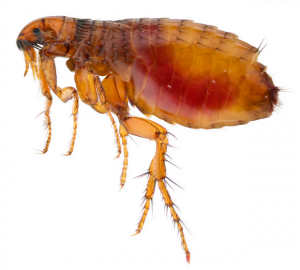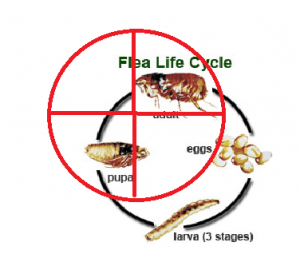June 20, 2016
Dealing with Fleas
Ancient Pests
In 2014, a professor at Capital Normal University in Beijing, Chungkun Shih and his colleagues discovered the oldest known flea. The ancient parasites [known as Pseudopulicidae] were unearthed in 165-million-year-old mud sediments in northeastern China.
Pseudopulicidae had huge, 0.8 inch-long (2 centimeters) bodies with long tubes for sucking blood and sharp, saw like teeth. Those ancient fleas quite likely fed on the blood of thick-skinned and feathered dinosaurs that lived during the Jurassic Period

So drawing a line from those Jurassic fleas to our modern twenty first century versions one thing stands out – adaptability!
For this insect to adapt from then living on huge dinosaurs to now thriving on cats and dogs is quite impressive.
So to combat these guys we need to adopt a strategy with multiple angles of approach.
A one hit wonder of “just flea bomb the joint” or the good old “slip on a flea collar” just won’t cut it, results wise.
How to beat fleas?
Controlling fleas is not that hard, for our Acacia Pest Control team members. We have access to a couple of very good product formulations that allow us to guarantee our results every time. In fact we give six months warranty on all our flea treatments.

Looking at my diagram, you can see the two points in the flea life cycle that we target – the pupa and adult flea.
When the adult female lays her eggs- up to 50/day, on strands of grass, twigs, carpet, etc the eggs hatch in 2 to 3 days. The larval stage is around for 5 to 10. Then the larva spin their cocoon and pupate inside. Now the waiting begins, the pupae sit and wait [sometimes for months] for movement and vibration. This vibration is the moment when they hatch and the adults emerge. This is the point that our control starts. The pupae are protected inside their cocoon, but the moment they emerge they are susceptible to our products.
The young and mature adults are controlled within a few days by our slow acting but long lasting products. However there is a time delay involved as the eggs, larva and pupa cycle has to complete before we see our susceptible adults and the control happens.
Help us Help you
You the home owner can play a part and speed the flea control process up!
If you create the vibrations- mowing lawns, vacuuming the carpets or holding a dance party for twenty 5 year olds, the movement and vibrations will stimulate the pupae to emerge in a short period of time, possibly hours. Otherwise the pupae can sit for quite a while and you will likely have adult fleas presenting themselves months later.
This can be quite frustrating, so better to hold the party and speed up the whole process.
In a Nutshell
Basically, modern fleas can take weeks – sometimes months to complete their life cycle, depending on their environment. So when we carry out pest control for your flea problem, it will really help you to create ‘good vibrations’ to quicken the life cycle, make them susceptible to the pest control products and therefore create a much faster result.

